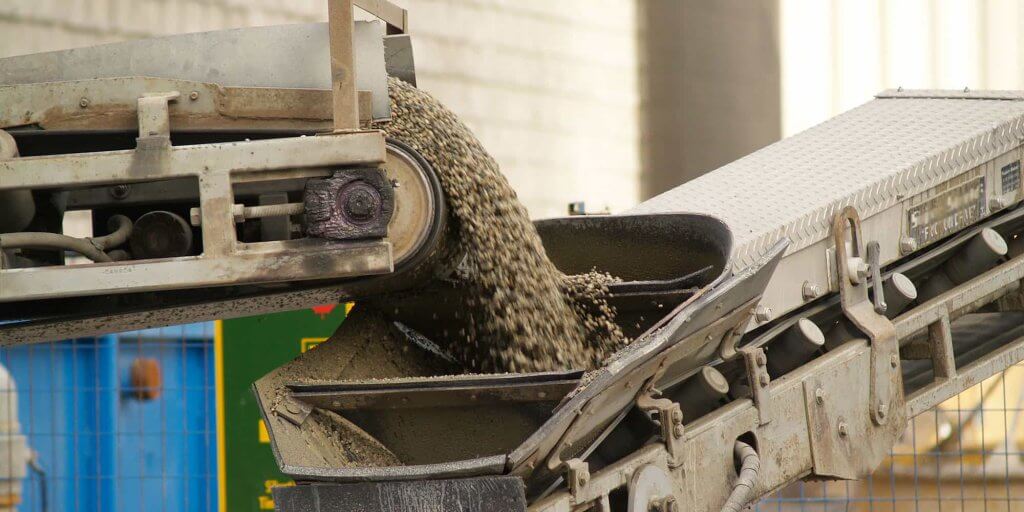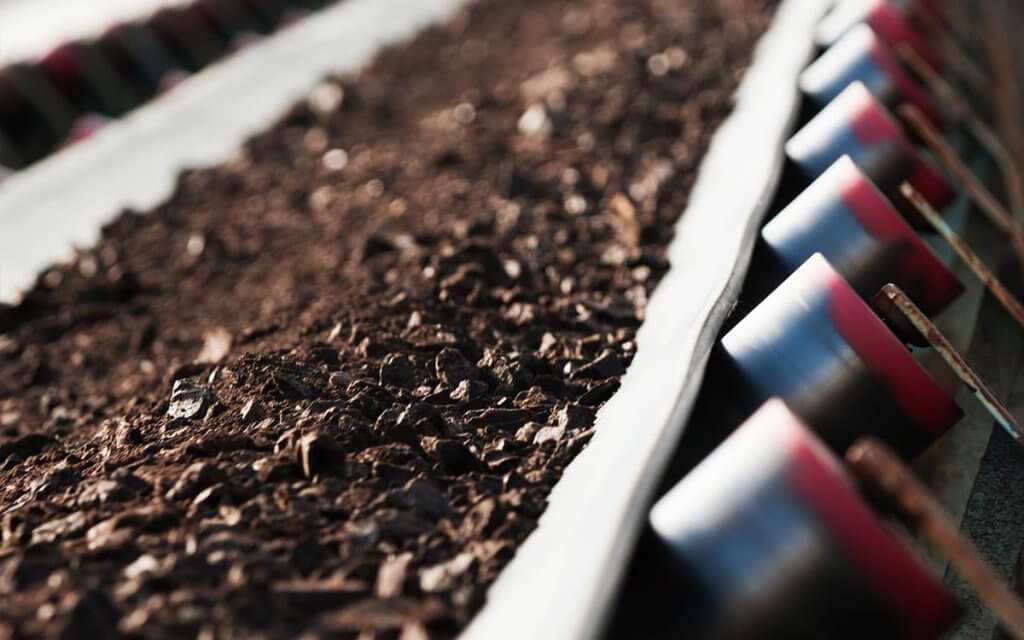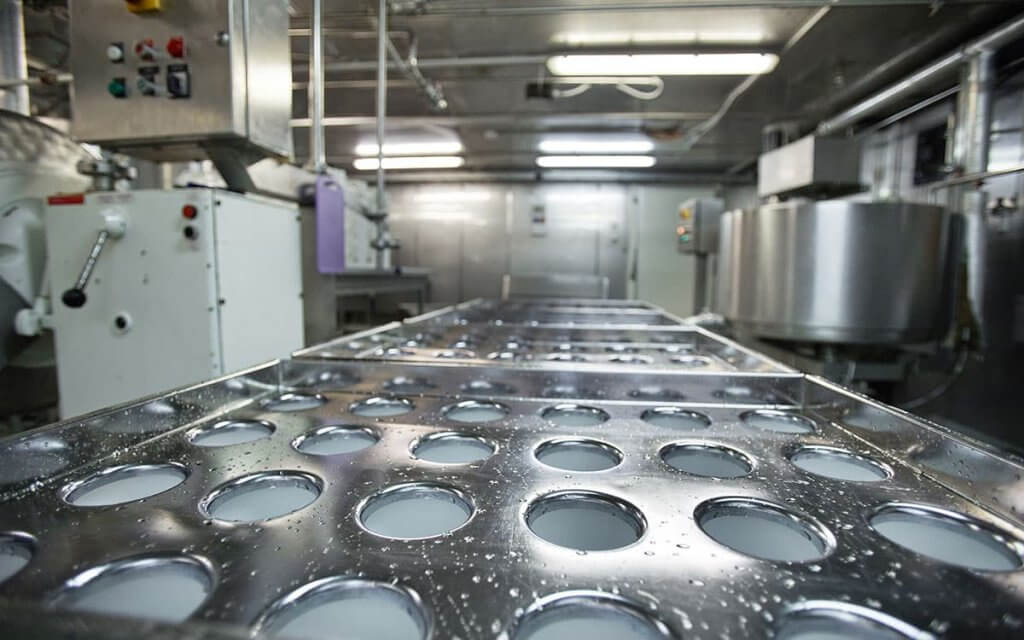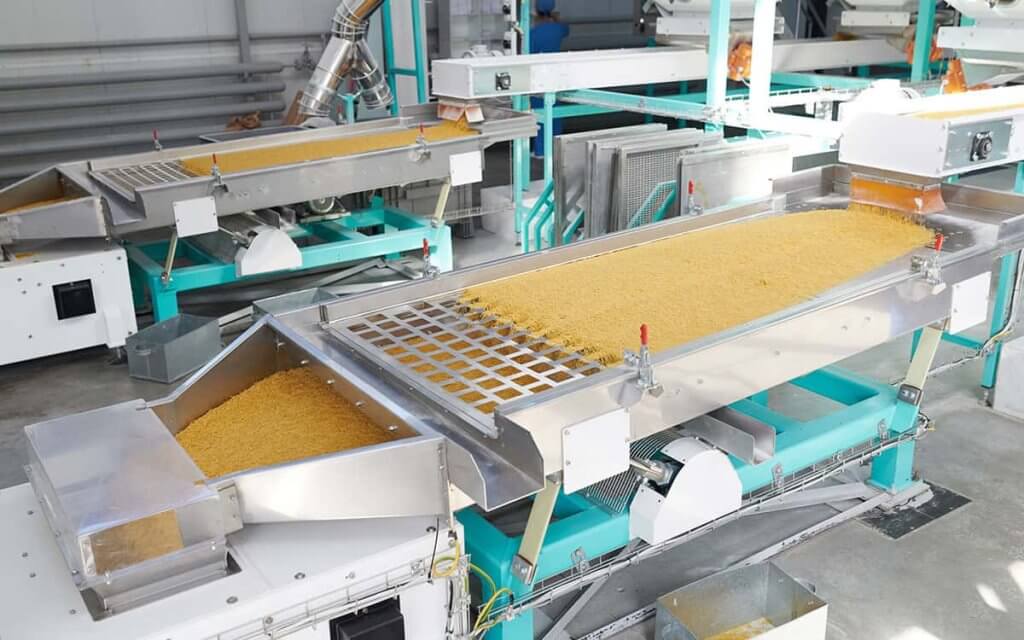Belt conveyor types and applications in manufacturing plants
A comprehensive guide
What's in the guide

The belt conveyor plays a crucial role in the industrial sector, especially in bulk material handling processes. It is a popular choice for conveying powders and granules in manufacturing plants due to its efficiency and versatility. With numerous options available in the market, it’s essential to select the right belt conveyor for your manufacturing plant.
This guide explores the different types of belt conveyors and their specific applications, providing valuable insights for senior technical plant managers.
Belt conveyor types
Flat Belt Conveyor
The most common belt conveyor is the flat belt conveyor, consisting of a flat belt material stretched over several pulleys. It is used for moving materials horizontally or at a slight incline and is ideal for transporting light to medium loads.
- Application: Primarily used for horizontal or near-horizontal material transport.
- Layout suitability: Ideal for both short- and long-distance runs within a single plane. It is commonly used in assembly lines, packaging, and sorting operations where a straight path is required.
- Technical considerations: It can handle a variety of load sizes and shapes but is less effective at steep inclines due to potential slippage of materials.
Cleated Belt Conveyor
This conveyor has cleats or barriers on the belt surface, providing extra support for materials moving at steeper angles. This design prevents the powders or granules from sliding back.
- Application: Best suited for inclines or declines in the conveyor path.
- Layout suitability: Useful in multi-plane layouts where materials need to be transported at an angle, especially in tight spaces where a traditional incline conveyor would be too steep.
- Technical considerations: The height and spacing of cleats can be customised based on the granule size and angle of incline, ensuring minimal slippage and controlled material flow.
Incline/Decline Belt Conveyor
Specifically designed for moving materials vertically or at an angle, this conveyor is essential in facilities where space is limited. The angle of incline is adjustable to accommodate different types of materials.
- Application: Specifically designed for vertical or steep transport of materials.
- Layout suitability: Optimal for facilities with multi-level operations where materials need to be moved between different elevations.
- Technical considerations: The steepness of the conveyor is a critical factor and is balanced with the nature of the material to prevent slide-back.
Curved Belt Conveyor
The curved belt conveyor is designed with a curved frame that allows the conveyor to turn corners or navigate around obstacles. It is useful in complex plant layouts where a straight conveyor would be impractical.
- Application: Utilised for changing the direction of material flow within a plant.
- Layout suitability: Effective in complex layouts where materials need to navigate around obstacles or turn corners without transferring to another conveyor.
- Technical considerations: The curvature radius needs to be large enough to prevent material spillage while maintaining belt integrity and efficiency.
Slider Bed Belt Conveyor
In this system, the belt slides over a flat surface, reducing friction. This design is suited for longer distances and heavier loads, making it a good choice for transporting granules or powders over longer distances within a plant.
- Application: Suitable for longer, horizontal or low-incline runs.
- Layout suitability: Ideal for straight paths across long distances within a plant, such as in warehousing or distribution sections.
- Technical considerations: The friction between the bed and the belt needs to be managed, especially for heavier loads or longer distances, to ensure smooth operation and minimise wear.
Roller Bed Belt Conveyor
Unlike a slider bed, this conveyor uses rollers to support the belt. This reduces friction and allows for heavier loads and longer conveying distances. It is particularly effective for high-volume material handling.

- Application: Used for heavy loads and long-distance transport.
- Layout suitability: Appropriate for straight, long-distance routes, especially in areas like shipping and receiving or bulk material handling.
- Technical considerations: Roller support reduces belt friction and wear, allowing for heavier loads and reduced energy consumption.
Modular Belt Conveyor
This conveyor uses a belt made up of individual, interlocked pieces. It is highly durable and easy to clean, making it suitable for food or pharmaceutical manufacturing where hygiene is crucial.
- Application: Versatile, used for straight, incline, and even curved paths.
- Layout suitability: Highly adaptable to complex layouts with multiple planes and directions, including tight turns and small footprints.
- Technical considerations: Modular design allows for easy maintenance and replacement of damaged sections. The design also accommodates a wide range of product sizes and shapes.
Sanitary and Washdown Belt Conveyor
Designed for environments where cleanliness is essential, this conveyor is made with materials that can withstand rigorous cleaning protocols. It is ideal for transporting powders and granules in food, pharmaceutical, and chemical industries.

- Application: Designed for environments requiring high hygiene standards.
- Layout suitability: Commonly used in food processing, pharmaceuticals, and chemical industries where the conveyor path needs regular cleaning and sanitisation.
- Technical considerations: Made with corrosion-resistant materials and designed for easy cleaning and drainage. The layout must allow for accessibility for regular washdowns.
Each type of belt conveyor has its unique advantages and is chosen based on the specific requirements of the material being transported, the layout of the manufacturing plant, and the necessary handling capacity.
Small, mini and portable belt conveyors
Small and mini belt conveyors are essentially scaled-down versions of standard belt conveyors. They are designed for situations where space is limited or the volume of material to be handled is relatively small.
Flat belt conveyors
- Application: Common in industries like electronics, pharmaceuticals, and fine mechanical assembly where precision and compactness are crucial.
- Technical considerations: Available in small and mini sizes, ideal for transporting light loads or small items.
Incline/decline belt conveyors
- Application: Suitable for facilities where a full-sized incline conveyor is impractical due to space limitations.
- Technical considerations: Miniaturized incline or decline conveyors are used for moving materials between different levels in a confined space.
Modular belt conveyors
- Application: Small modular conveyors provide flexibility and durability, particularly useful in small-scale food processing or packaging lines.
- Technical considerations: Their modular nature allows them to be customized for specific pathways and product sizes.
Portable or mobile belt conveyors are designed for temporary or movable operations. They are typically used in situations where a fixed installation is either not feasible or unnecessary.
Telescopic belt conveyors
- Application: These can be extended into trucks or other areas for loading or unloading materials, commonly used in logistics and warehousing.
- Technical considerations: The mobility and adjustability make them highly versatile for various loading and unloading tasks.
Wheel-mounted mobile conveyors
- Application: Often used in mining, agriculture, or construction where the conveyor needs to be moved over a site or between multiple sites.
- Technical considerations: These conveyors are mounted on wheels or tracks and can be easily relocated.
Curved belt conveyors
- Application: Portable versions of curved conveyors are used in events, temporary setups, or in operations where the layout changes frequently.
- Technical considerations: The flexibility to adapt to different angles and spaces makes them valuable in dynamic environments.
Key considerations
These types of conveyors are best suited for specific tasks – small and mini conveyors for light or precision tasks, and portable conveyors for temporary or dynamic operations.
While small, mini, and portable conveyors offer flexibility and space-saving advantages, their capacity and throughput are typically lower than standard conveyors. This should be factored into decision-making based on material handling requirements.
Consideration also needs to be given to how these specialised conveyors will integrate with existing systems and processes. Their utility often depends on how well they complement larger systems.
Advantages of belt conveyors
Understanding the diverse capabilities of belt conveyors is crucial in optimising bulk material handling processes.
Versatility with different materials
Belt conveyors can handle a wide range of materials, including powders, granules, and larger items. It is less likely to cause material segregation or degradation, which can be a concern with pneumatic systems.
- Gentle handling: It provides a smooth and consistent flow, minimising the chances of damaging fragile materials. This is a significant advantage over systems like screw conveyors, which can be more abrasive.
- Customisable for specific materials: The belt material, cleat design, and conveyor speed can be tailored to suit specific material characteristics, ensuring optimal material handling and reduced spillage.
- Reduced dust generation: Enclosed belt conveyor designs can significantly reduce dust generation, crucial for handling powders and granular materials, and for maintaining a clean plant environment.
Plant layout and route advantages
The flexibility of belt conveyors allows for innovative plant layout designs, enhancing operational efficiency.
- Flexibility in layout design: A belt conveyor can be designed to fit various plant layouts, accommodating straight, curved, inclined, or declined paths, which might be challenging for rigid systems like screw conveyors.
- Long-distance conveying capability: It is deal for covering long distances within a plant, which can be less feasible or more expensive with technologies like pneumatic conveyors due to energy inefficiency over long distances.
- Space efficiency: Belt conveyors can be designed to maximise space usage, with options for overhead routing or tight turns, making them suitable for plants with limited space.
- Elevation changes: Capable of incline or decline conveying, belt conveyors can effectively move materials between different levels within a plant, which is a limitation for some conveyor types like vibrating conveyors.
- Integration and expansion flexibility: Belt conveyors can be easily integrated into existing production lines and can be expanded or reconfigured as plants need change. This adaptability is a significant benefit over more static systems.
Key benefits of belt conveyors
Belt conveyors offers numerous benefits, making it a smart choice for many manufacturing environments.
- Cost-effectiveness: Generally, belt conveyors have lower installation and maintenance costs compared to systems like pneumatic conveyors.
- Energy efficiency: They are more energy-efficient for long-distance transport compared to pneumatic or vacuum systems.
- Ease of maintenance: Belt conveyors have simpler mechanics and easier accessibility for maintenance and repairs compared to more complex systems.
Where you may come unstuck
While belt conveyors are versatile and widely used in bulk material handling, there are specific scenarios where they may not be the best choice.
- Excessive load weight: Belt conveyors have a maximum load capacity. Extremely heavy loads can strain the conveyor belt, leading to increased wear, potential breakdowns, or the need for more robust and costly conveyor systems.
- Highly abrasive materials: If the materials being transported are highly abrasive, they can wear down the conveyor belt quickly, necessitating frequent replacements and increasing maintenance costs.
- Very high temperatures: Standard conveyor belts can be damaged by extremely high temperatures. While there are heat-resistant belts, they may not be sufficient for some high-temperature applications, such as transporting materials directly out of a furnace.
- Wet or sticky materials: Materials that are wet, sticky, or have a tendency to clump can adhere to the belt surface, causing cleaning and maintenance challenges. This can disrupt the conveyor’s efficiency and lead to more frequent stoppages for cleaning.
- Chemically reactive materials: Certain chemicals or materials might react with the material of the conveyor belt, leading to degradation or damage. In such cases, specialided materials are required, which might be more expensive or difficult to source.
- Sharp or jagged materials: Sharp or jagged objects can cut or tear the conveyor belt, especially if the belt is not designed for such materials. This can lead to frequent belt replacements and increased downtime.
- Complex bulk material handling requirements: While belt conveyors are adaptable, they might not be the best choice for extremely complex routing requirements, like those requiring frequent changes in direction or elevation within a very confined space.
- Explosive or flammable materials: The motion of the conveyor belt can generate static electricity, which could be a hazard when transporting flammable or explosive materials unless specific safety measures are in place.
- Sanitary and cleanroom environments: In environments where absolute cleanliness is necessary, such as in certain pharmaceutical or food processing applications, the nooks and crannies in conveyor belts and frames can harbor bacteria or contaminants.
- Outdoor or uncontrolled environments: Belt conveyors are less suited for outdoor use where they can be exposed to weather elements like rain, snow, or extreme temperatures, unless they are specifically designed for such conditions.
In each of these cases, alternative bulk material handling systems might be more appropriate, such as pneumatic systems for complex routes or high-temperature materials, bucket elevators for vertical transport of larger granules and lumps, or screw conveyors for wet, sticky, or chemically reactive materials, or aero-mechanical conveyors for sealed conveying and the preservation of valuable materials. The suitability of a belt conveyor system largely depends on the specific material characteristics, environmental conditions, and the operational requirements of the plant.
Critical advice for plants considering the implementation of a belt conveyor
Implementing a belt conveyor system requires a strategic approach, considering various factors for optimal performance.

Assess material characteristics
- Understand the properties: Evaluate the physical properties of the materials being handled (e.g., size, abrasiveness, stickiness, temperature sensitivity) to select the appropriate belt material and design.
- Consider material impact: Factor in how the conveyor will affect the material, especially if it’s fragile, prone to degradation, or reactive.
- Analyse plant layout and space constraints
- Map the route: Plan the conveyor path, considering existing structures and machinery. Belt conveyors offer flexibility, but it’s crucial to design an efficient route.
- Space utilization: Optimise space, especially in confined areas. Vertical or inclined conveyors can save floor space.
- Evaluate long-term operational costs
- Energy consumption: Consider the energy efficiency of the conveyor system, especially for long runs, as this impacts ongoing operational costs.
- Maintenance requirements: Regular maintenance is key for longevity. Choose a design that simplifies maintenance tasks and minimises downtime.
- Prioritise safety and compliance
- Safety features: Incorporate safety guards, emergency stops, and other features to protect workers.
- Regulatory compliance: Ensure the conveyor system complies with industry-specific regulations, particularly in food, pharmaceutical, or chemical industries.
- Customisation for specific needs
- Modular design: Opt for a modular conveyor design that allows for easy expansion or reconfiguration.
- Tailor for bulk material handling: Customise the conveyor (e.g., belt type, cleat design) based on the specific materials to be handled.
Consider integration with existing systems
- Seamless integration: Ensure the conveyor can be integrated smoothly with existing production lines or material handling systems.
- Automation compatibility: Check if the conveyor can be linked with automation systems for streamlined operations.
Plan for future scalability
- Adaptability: Choose a system that can grow or change with your plant’s future needs. This could involve extending the conveyor length, increasing capacity, or altering the route.
Assess environmental impact
- Dust and contamination control: If handling powders or granules, consider enclosed conveyors to minimize dust and contamination.
- Noise levels: Evaluate the noise generated by the conveyor and its impact on the work environment.
Consult with conveyor specialists
Engage with conveyor experts or manufacturers early in the planning phase to leverage their expertise in bulk material handling conveyor designs and material handling.
Cost-benefit analysis
Perform a detailed cost-benefit analysis, considering not only the initial investment but also long-term operational and maintenance costs.
Quality and durability of components
Invest in high-quality components to reduce long-term costs associated with repairs and replacements.
Conclusion
Selecting and designing a belt conveyor system requires a holistic approach, considering material properties, plant layout, operational efficiency, safety, and regulatory compliance. Customisation and flexibility are key to ensuring that the conveyor system not only meets the current needs but can also adapt to future changes and expansions. Consultation with specialists and thorough planning are essential for implementing the right bulk materials handling conveyor system for your plant.
If you’re considering a conveyor system for your next bulk powder or granule handling project, get in touch with Floveyor. As powder handling specialists with a long history, we can help you determine the best conveyor for your manufacturing plant.
